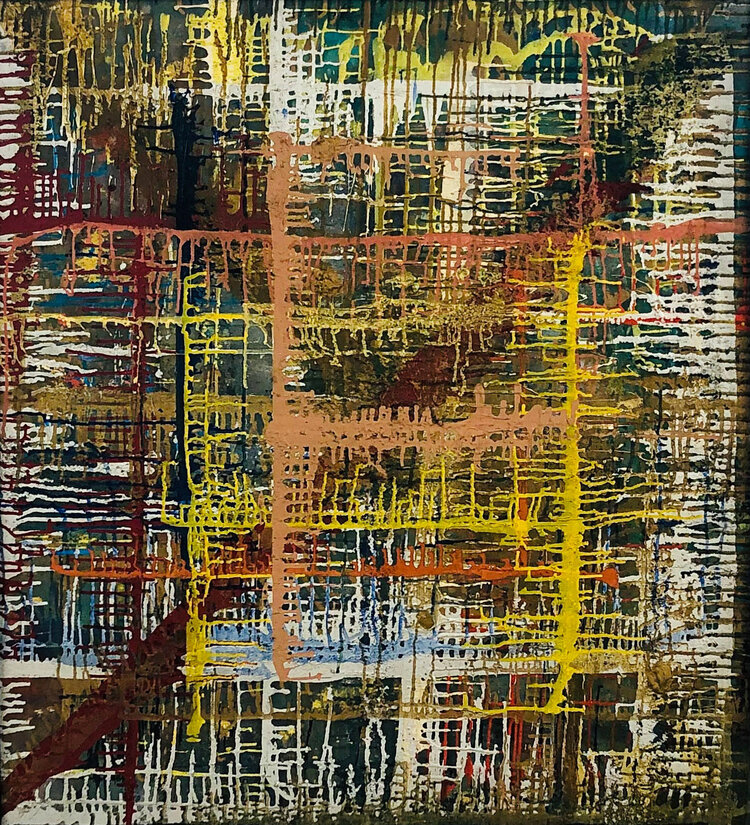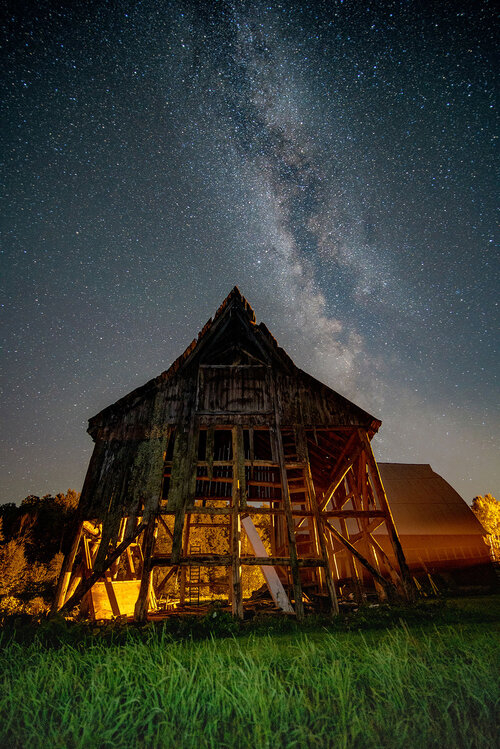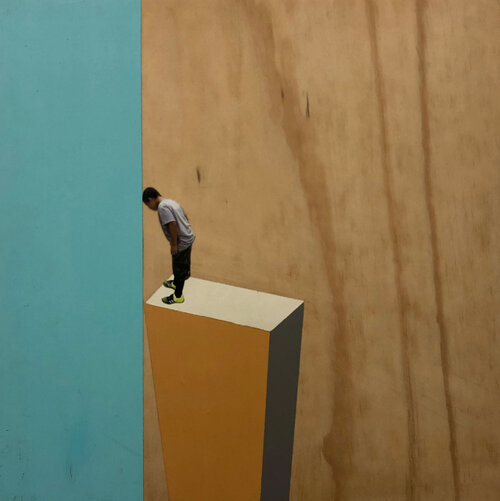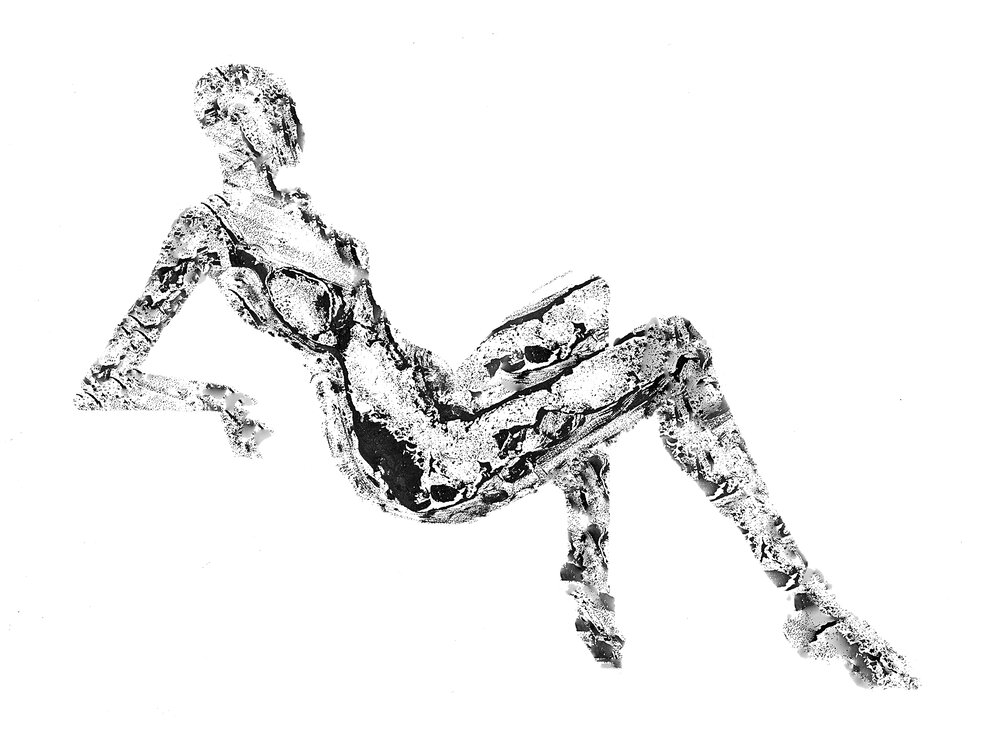
This past October was the opening of Artwork/An Exhibition at SBM (Small Bands of Misbehavior)
Studio 929 Canal. The pop up gallery was situated in Middletown, NY, in a film studio run by Courtenay Williams and Kai Lee -- a place where "creating environments, transforming spaces, strengthening context, and shaping experiences" has been their primary focus over the past ten years. I met Courtenay and Kai a few years ago, when I was working as a scenic artist on a crew run by Roman Turovsky, and I was immediately impressed by their unique approach to production design and direction. Impressed because they were both extremely respectful and mindful towards all crews and members, handling every aspect of the job with a very high level of professionalism, and without talking down to.

With all this stated, I was happy to take the long drive up to their place of business to see what they had in store fine art-wise, for their local, Middletown community. The exhibition, which featured the work of over a dozen solo artists and co-conspirators, was tremendously diverse in style and media. The premise of the exhibition is that most artists, unless they are independently wealthy, must work in another or related field to survive and create. For instance, Victor Barroso, who works as a VFX Compositor (a mixer of digital and live action footage) and Non-Union Scenic, offered a drip painting that focused on the potential of controlling chaos. Untitled (1981), a canvas that was begun with a rough color field approach dominated by a bold diagonal that split the canvas in half, was riddled afterwards with colorful veils of drips cascading from all four sides. By spinning the canvas as he worked, Barosso created something of a nerve network, tension in depth that precisely recorded time and space.
Daniel Grant, a Maker of Contemporary Furniture and Accessories, revealed a kinship with indigenous peoples as his paintings reflect the aesthetics of Native Americans and Aboriginal Australians. A most striking connection is Arrival (1984), which reminded this reviewer of how Aboriginal artists very often focused on the location of water in their mesmerizingly beautiful, and often dream-like compositions. On the other hand, Unbound (1979) is far more spiritual in its intent, linking all earthly beings to the higher power of the Gods of nature.

Andrew Heikkila, a Union Prop Specialist, presented three inspiring color photographs that uncover the more magical effects of light. Makela Tree and Bryce Canyon, both from 2019, illustrate the endless possibilities in nature both earthly and heavenly. Old Hay Barn of the same year is far more theatrical in its narrative as selective spot lighting intensifies the drama and the dynamics. With all three, there remains that endlessness, near feeling of vertigo triggered by the presence of the Milky Way. Judith Hoyt, a Childcare Provider, creates assemblages that fall primarily into the category of Folk Art, often hinting at and referencing Dada and Surrealism. One common link throughout her work is a nod to nature, while the found rusted metal she incorporates in her compositions illustrates one of the more relentless aspects of nature, its ability to reclaim lost elements.
Margot Kingon, who works as a Union Electrician, had a number of curiously composed and fastidiously fabricated works on display that are more current today, than the day they were made. In this time of a global pandemic, our entire planet is dealing with a number of issues and emotions including anxiety, fear and loneliness. Wall/Boy (2017), Boy Looking Out (2015) and Mountain Boy (2017) in particular reflect isolation and a lack of information, as we often feel frustrated by worsening mismanagement, a lack of leadership and endlessly contrasting information.

Todd Koelmel, an Engineer, appropriated a sort of 1960's Hard Edge approach to making landscape and seascape paintings. By minimizing representations of form and color, Koelmel gets down to the essence of the visual experience, while simultaneously broadening the scope of the understanding. James Lee, the retired Editorial Art Director, offered his version of landscape painting with Fraser Valley. Painted in 1958. Fraser Valley exemplifies a far more atmospheric approach to the representation of nature than Koelmel, an approach that left me with a soothing and comforting view of a bucolic valley where I could truly feel the moment and almost smell the pines.
David Lionheart, Founder of the Non-Profit for Veterans -- playforyourfreedom.org, turns wild color schemes and tumultuous texturing into challenging imagery. With titles like The Joker, The Cocktail Waitress and The Hunted, Lionheart offered puzzling representations of tangible subjects through distinctly non-representational means. Another Maker of Contemporary Furniture and Accessories is Ingela Noren. In this instance, there was an inclination to the applied arts, as Noren applies unique design concepts and bold techniques to functional, everyday objects.

James Palacios, a Cook, merged multiple cultural and emotional references in a boldly blended narrative in Untitled (2019). Here, two partial figures, one a seated male and the other a portrait of a female, are dually interlocked in an endless pattern of power and destabilization. Even with the obvious pain suggested here, Palacios managed to create a mesmerizing visual that kept this viewer engaged, as the artist drives home his point -- the cycle of sorrow is most often facilitated by an enabler.
Jane Resnick, the retired Photo Stylist, presented a large variety of wood-fired ceramic vessels expressing a range of aesthetics and forms from classic design to the more organic, and even the futuristic. All together, they formed an impressive and insightful range of quality results. C. E. Williams, SBM -- Creative Studio Co-Owner and Union Production Designer, displayed a challenging representation of the female form with a work form the Topophilia series (2017-ongoing). The subject, in repose and suspended above a segmented seating arrangement, projects confidence and stature. Conversely, the multitude of textures and transitions in black and white that give the figure volume also suggest erosion and fallibility. Think Yves Klein Anthropométries sans the iconic blue, but more resolved anatomically.

Kai Lee, SBM – Creative Studio Co-Owner and Union Production Designer, teams with the aforementioned Williams to repurpose various colored Plexiglas, LEDs and aluminum in the creation of I Don't Know Where the Sidewalk Ends (2019). Here, I experienced two alluring portals crossing, perhaps indicating the convergence or overlap of unseen dimensions. String Theorists can end up with anywhere between 10, 11, or 26 dimensions, a level of understanding that is way beyond my ability to grasp or imagine. However, the possibility of there being more than the easily perceivable dimensions we live with every day: length, width and height –- maybe throwing in space-time, is endlessly intriguing. To work with and around those mind-bending concepts, and to hint at far greater possibilities, as experienced with I Don’t Know Where the Sidewalk Ends, gave me and many others much to contemplate.
